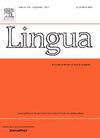普通话儿童三方对话中指称语篇的换位思考
IF 1.3
3区 文学
0 LANGUAGE & LINGUISTICS
引用次数: 0
摘要
在对话过程中,个体不断需要从他人的角度来约束引用域。本研究专门调查了三岁的普通话儿童在三方交流中如何看待两个伙伴的视觉视角。在两个实验中,两位说话者轮流指导孩子们识别架子上的物品,他们使用的关键名词在语义上与孩子视觉上看到的两个相同的指代物相匹配。然而,其中一个参照物可能对说话者不可见。关键名词以裸名词的形式呈现,允许在普通话语境中进行明确或一般的解释,导致单指和双指之间的竞争。在实验1中,当两个说话者只看到一个共同的候选物体时,孩子们更喜欢明确的解释,利用他们同伴的观点来缩小参考范围。然而,在实验2中,一个说话者可以看到两个候选对象,而另一个只能看到共享的对象。结果表明,儿童倾向于相似地解读双方的话语,并倾向于通用的解读。此外,眼球追踪数据表明,孩子们隐式地处理了每个伴侣的视觉视角。本研究揭示了三岁儿童在普通话环境下的视觉视角策略,并为儿童如何在交流中整合多种视角提供了见解。本文章由计算机程序翻译,如有差异,请以英文原文为准。
Perspective-taking in referential discourse among Mandarin-speaking children during three-party conversations
During conversations, individuals continuously need to take others’ perspectives to constrain the referential domain. The present study specifically investigates how 3-year-old Mandarin-speaking children take the visual perspectives of two partners in three-party communications. In two experiments, two speakers took turns instructing children to identify objects on a shelf, using critical nouns that semantically matched two identical referents from the child’s visual perspective. However, one of these referents might not be visible to the speakers. The critical nouns were presented in the form of bare nouns, allowing for definite or generic interpretations in the Mandarin context, leading to a competition between single and dual references. In Experiment 1, when both speakers only saw one shared candidate object, children preferred definite interpretations, using their partners’ perspectives to narrow the referential domains. However, in Experiment 2, one of the speakers could see both candidate objects while the other could see only the shared one. Results showed that children tended to interpret both partners’ discourse similarly and preferred generic interpretations. Additionally, eye-tracking data indicated that children implicitly processed each partner’s visual perspective. This research sheds light on visual perspective-taking strategies among 3-year-old children in a Mandarin context and provides insight into how children integrate multiple perspectives in communication.
求助全文
通过发布文献求助,成功后即可免费获取论文全文。
去求助
来源期刊

Lingua
Multiple-
CiteScore
2.50
自引率
9.10%
发文量
93
审稿时长
24 weeks
期刊介绍:
Lingua publishes papers of any length, if justified, as well as review articles surveying developments in the various fields of linguistics, and occasional discussions. A considerable number of pages in each issue are devoted to critical book reviews. Lingua also publishes Lingua Franca articles consisting of provocative exchanges expressing strong opinions on central topics in linguistics; The Decade In articles which are educational articles offering the nonspecialist linguist an overview of a given area of study; and Taking up the Gauntlet special issues composed of a set number of papers examining one set of data and exploring whose theory offers the most insight with a minimal set of assumptions and a maximum of arguments.
 求助内容:
求助内容: 应助结果提醒方式:
应助结果提醒方式:


